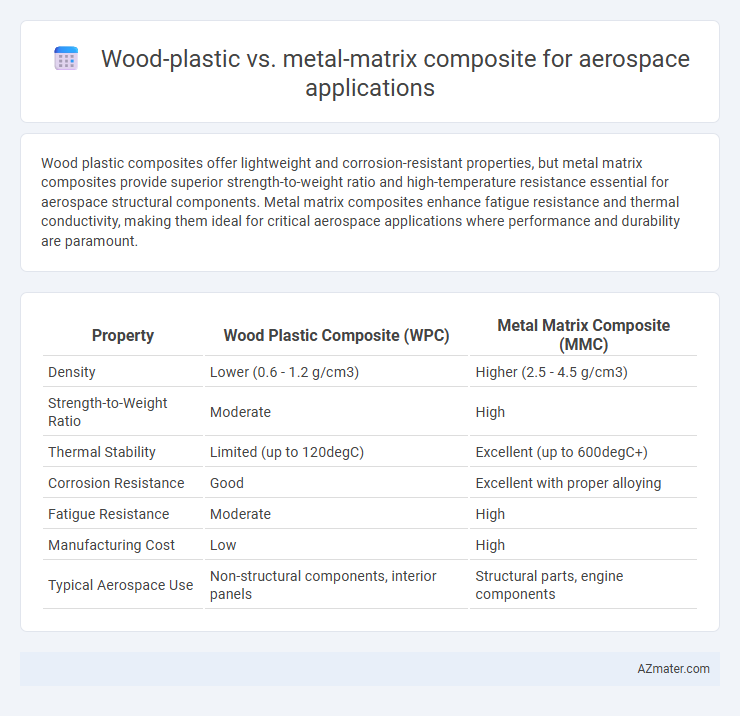Wood plastic composites offer lightweight and corrosion-resistant properties, but metal matrix composites provide superior strength-to-weight ratio and high-temperature resistance essential for aerospace structural components. Metal matrix composites enhance fatigue resistance and thermal conductivity, making them ideal for critical aerospace applications where performance and durability are paramount.
Table of Comparison
| Property | Wood Plastic Composite (WPC) | Metal Matrix Composite (MMC) |
|---|---|---|
| Density | Lower (0.6 - 1.2 g/cm3) | Higher (2.5 - 4.5 g/cm3) |
| Strength-to-Weight Ratio | Moderate | High |
| Thermal Stability | Limited (up to 120degC) | Excellent (up to 600degC+) |
| Corrosion Resistance | Good | Excellent with proper alloying |
| Fatigue Resistance | Moderate | High |
| Manufacturing Cost | Low | High |
| Typical Aerospace Use | Non-structural components, interior panels | Structural parts, engine components |
Introduction to Aerospace Material Needs
Aerospace materials must exhibit exceptional strength-to-weight ratios, thermal stability, and corrosion resistance to withstand extreme operational environments. Wood plastic composites offer lightweight solutions with good vibration damping but lack the high-temperature tolerance required for critical aerospace components. Metal matrix composites provide superior mechanical properties, high stiffness, and enhanced thermal conductivity, making them more suitable for structural and high-performance aerospace applications.
Overview of Wood Plastic Composites
Wood plastic composites (WPCs) consist of wood fibers or flour combined with thermoplastics like polyethylene, polypropylene, or polyvinyl chloride, offering lightweight and corrosion-resistant properties ideal for certain aerospace components. Their natural fiber reinforcement provides enhanced vibration damping and relatively low density, which supports fuel efficiency and structural performance in non-critical aerospace applications. While WPCs lack the high-temperature resistance and strength of metal matrix composites (MMCs), their environmental sustainability and ease of processing present valuable advantages for interior aerospace parts and non-structural elements.
Overview of Metal Matrix Composites
Metal Matrix Composites (MMCs) combine lightweight metals such as aluminum or titanium with reinforcing fibers or particles to enhance mechanical properties like strength, stiffness, and thermal resistance. They offer superior temperature tolerance and corrosion resistance compared to Wood Plastic Composites (WPCs), making them highly suitable for aerospace structural components and engine parts. MMCs enable weight reduction and improved performance under extreme operational conditions, critical for advancing aerospace technology.
Mechanical Properties Comparison
Wood plastic composites exhibit lower tensile strength and stiffness compared to metal matrix composites, limiting their use in high-load aerospace components. Metal matrix composites offer superior mechanical properties such as higher strength-to-weight ratio, enhanced fatigue resistance, and improved thermal stability, making them ideal for aerospace structural applications. The ability of metal matrix composites to withstand extreme temperatures and corrosive environments without significant degradation outperforms the relatively lower durability and mechanical performance of wood plastic composites in aerospace contexts.
Weight and Density Considerations
Wood plastic composites (WPCs) offer significantly lower density, typically around 1.0-1.4 g/cm3, compared to metal matrix composites (MMCs) with densities ranging from 2.7 g/cm3 (aluminum-based) to over 7.8 g/cm3 (steel-based), making WPCs advantageous for lightweight aerospace components aimed at fuel efficiency and reduced payload. Despite the higher strength-to-weight ratio of MMCs, their increased density can lead to heavier structures, impacting overall aircraft performance and operational costs. Weight reduction achieved by WPCs contributes to improved aerodynamic efficiency and lower emissions, critical factors in modern aerospace design.
Thermal Performance Analysis
Metal matrix composites (MMCs) exhibit superior thermal conductivity and stability compared to wood plastic composites (WPCs), making MMCs more suitable for aerospace applications that demand efficient heat dissipation and thermal resistance under extreme conditions. Wood plastic composites, while offering lightweight and corrosion-resistant properties, typically show lower thermal conductivity and can experience degradation at elevated temperatures, limiting their use in high-performance thermal environments. Advanced thermal performance analysis demonstrates that MMCs maintain structural integrity and performance at high temperatures, ensuring safety and reliability in aerospace components exposed to intense thermal cycles.
Durability and Environmental Resistance
Wood plastic composites (WPCs) offer moderate durability and resistance to moisture but are generally less suitable for the extreme temperature and oxidative environments encountered in aerospace applications compared to metal matrix composites (MMCs). MMCs, typically composed of aluminum or titanium alloys reinforced with ceramic fibers or particles, provide superior durability, high strength-to-weight ratios, and excellent resistance to thermal degradation, oxidation, and corrosion. These properties make MMCs more reliable and long-lasting under the rigorous mechanical stresses and environmental conditions typical in aerospace engineering.
Manufacturing and Processing Techniques
Wood plastic composites (WPCs) offer lightweight properties and ease of manufacturing through extrusion, injection molding, and compression molding, making them suitable for non-structural aerospace components. Metal matrix composites (MMCs), processed via powder metallurgy, stir casting, and squeeze casting, provide superior strength-to-weight ratios and thermal resistance essential for critical aerospace structures. Advanced MMC manufacturing techniques such as hot isostatic pressing and additive manufacturing enable precise microstructural control and improved mechanical performance for aerospace applications.
Cost Implications and Sustainability
Wood plastic composites (WPCs) offer lower production and material costs compared to metal matrix composites (MMCs), making them economically attractive for aerospace components with non-structural applications. MMCs provide superior strength-to-weight ratios and thermal resistance, but their manufacturing complexity and raw material expenses significantly increase overall costs. From a sustainability perspective, WPCs utilize renewable wood fibers and recyclable polymers, reducing environmental impact, whereas MMCs often involve energy-intensive processes and limited recyclability, challenging their eco-friendliness in aerospace use.
Suitability and Future Trends in Aerospace Applications
Metal matrix composites (MMCs) demonstrate superior suitability for aerospace applications due to their high strength-to-weight ratio, thermal stability, and resistance to fatigue and corrosion, making them ideal for structural components exposed to extreme conditions. Wood plastic composites (WPCs), while lightweight and sustainable, currently lack the necessary mechanical properties and thermal resistance required for critical aerospace parts, limiting their use primarily to interior panels or non-structural applications. Future trends indicate increased research into hybrid composites combining MMCs with bio-based materials to enhance sustainability without compromising performance, alongside advancements in additive manufacturing techniques for tailored aerospace components.

Infographic: Wood plastic vs Metal matrix composite for Aerospace application
 azmater.com
azmater.com